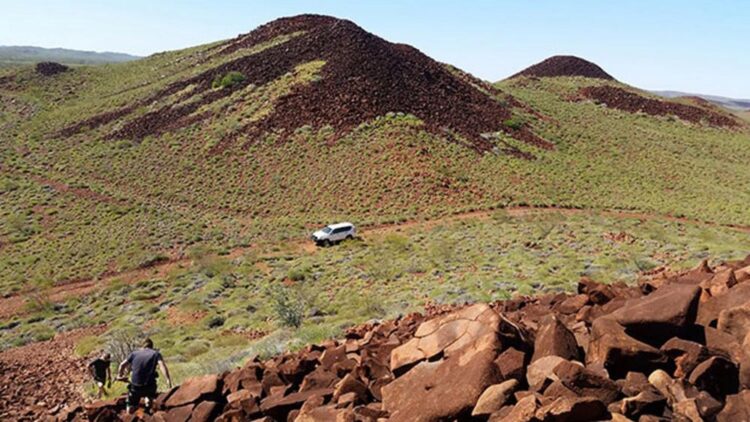Slow start of plate tectonics despite a hot early Earth

In the barren landscapes of NW Australia (in the so-called Pilbara Craton) the Cologne geologists examined rocks from the early phase of the earth (Archean).
(Photo: © Christian S. Marien)
Writing in PNAS, scientists from Cologne university present important new constraints showing that plate tectonics started relatively slow, although the early Earth’s interior was much hotter than today.
In an international collaboration earth scientists at the University of Cologne discovered that during Earth’s early history mantle convection on, i.e. the internal mixing of our planet, was surprisingly slow and spatially restricted. This finding is unexpected because our planet was much hotter during the first hundreds of million years after its formation.
Therefore, it has been assumed that mantle convection on Earth was much faster in its infancy. According to their study „Convective isolation of Hadean mantle reservoirs through Archean time“, however, the earth did not experience full speed mantle convection until 3 billion years ago, when modern plate tectonics is believed to have fully operated.
For their study, the geologists investigated up to 3.5 billion years old igneous rocks from NW Australia that cover 800 million years of Earths early history. The analysis of these rock successions revealed that the oldest samples exhibit small anomalies in the isotope abundances of the element tungsten (W) that progressively diminish with time. The origin of these anomalies, namely the relative abundance of 182W, relates to ancient heterogeneities in the terrestrial mantle that must have formed immediately after formation of the Earth more than 4.5 billion years ago.
The preservation of these 182W anomalies in the igneous rocks from NW Australia demonstrate that pristine mantle reservoirs from the beginning of our planet were conserved over timescales exceeding more than one billion years. This finding is very surprising, because higher mantle temperatures in the early Earth suggest that mantle convection was more extensive and much faster than today.
Interestingly, the observed 182W anomalies start to diminish at around 3 billion years ago, within a geological era that is assumed to mark the beginning of modern plate tectonics. The onset of modern plate tectonics, involving subduction processes and mountain uplift, has been shown to be a key event triggering the emergence of large continental masses and an oxygen-rich atmosphere, all of which set the stage for the origin of more complex life.
Wissenschaftliche Ansprechpartner:
Media contact:
Jonas Tusch
Institut für Geologie und Mineralogie
j.tusch@uni-koeln.de
+49 221 470-89864
Prof. Dr. Carsten Münker
Institut für Geologie und Mineralogie
+49 221 470-3198
Press and Communications Team:
Mathias Martin
+49 221 470-1705
m.martin@verw.uni-koeln.de
Originalpublikation:
Media Contact
All latest news from the category:
Newest articles

First-of-its-kind study uses remote sensing to monitor plastic debris in rivers and lakes
Remote sensing creates a cost-effective solution to monitoring plastic pollution. A first-of-its-kind study from researchers at the University of Minnesota Twin Cities shows how remote sensing can help monitor and…

Laser-based artificial neuron mimics nerve cell functions at lightning speed
With a processing speed a billion times faster than nature, chip-based laser neuron could help advance AI tasks such as pattern recognition and sequence prediction. Researchers have developed a laser-based…

Optimising the processing of plastic waste
Just one look in the yellow bin reveals a colourful jumble of different types of plastic. However, the purer and more uniform plastic waste is, the easier it is to…